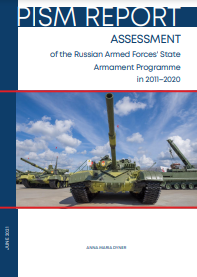Assessment of the Russian Armed Forces' State Armament Programme in 2011-2020
Assessment of the Russian Armed Forces' State Armament Programme in 2011-2020
Author(s): Anna Maria Dyner
Subject(s): Security and defense, Military policy, Policy, planning, forecast and speculation
Published by: PISM Polski Instytut Spraw Międzynarodowych
Keywords: Russia; Armed Forces; Armament Programme; 2011-2020; Assessment;
Summary/Abstract: Russia’s State Armament Programme (SAP) comprises medium-term plans for the technical modernisation of all the armed forces. It includes an analysis and assessment of threats to national security. The development of the SAP iterations is coordinated by the Ministry of Defence (MoD) and involves other ministries and the defence industry. The SAP is subject to periodic reviews, which lead to revisions based on experience from military operations and other testing and uses. Before the SAP for 2011-2020, Russia implemented other reforms and the SAP for 2007-2015, the primary goal of which was to increase the share of modern weapons in the armed forces to 30%. According to data presented by the Russian authorities (both the defence minister and the president), in 2020 the formal goal of the SAP for 2011-2020 had been achieved: the share of modern weapons exceeded 70%.1 It is difficult to properly assess the methodology adopted by the Russian MoD or indicate which portion of the armaments are completely new and which were only modernised and to what extent. SAP 2011-2020 was prepared under specific conditions. It was an integral part of the comprehensive reform of the Russian armed forces inaugurated in 2009. Moreover, it was created at a time when Russia, for the first time in its modern history, had at its disposal sufficient financial resources and technical capabilities to implement such reform, which was mainly possible due to the growing revenues from the sale of energy resources. The assumptions of the document also corresponded to the next version of the Russian military doctrine that was being developed at that time and subsequently published in 2010.2 In the 2010 doctrine, Russia identified as significant threats the creation and deployment of strategic missile defence systems that undermine global stability and upset the existing balance of strategic (nuclear) forces, the militarisation of outer space, and the deployment of strategic non-nuclear precision weapons systems. The document also emphasised that military operations would be characterised by the growing importance of precision electromagnetic and laser platform weapons, information systems, unmanned aerial vehicles and autonomous maritime vehicles. It pointed out that nuclear weapons will remain an important factor in preventing the outbreak of nuclear armed conflicts as well as certain conventional armed conflicts. The response to these challenges and threats was largely reflected in SAP 2011- 2020. One of the priorities was to modernise the strategic forces, which corresponded to the content of the doctrine in which Russia must maintain the condition of these forces, the level of combat readiness and the training of crews to a degree that guarantees damage to the aggressor under all conditions (in practice, this meant maintaining the capability of a retaliatory nuclear strike on a severe scale). The 2010 doctrine also assumed a comprehensive rearmament of military units to a level of constant combat readiness, as well as anti-terrorist, engineering, and technical forces. The Russian government set itself the goal of providing the armed forces with modern weapons, military and special equipment (material and technical resources) and increasing the technological capabilities of the defence industry as well as the quality of the weapons produced. An important task was ensuring technological independence from NATO countries or Ukraine, a traditional supplier, in the production of strategic and other weapons, as well as military and special equipment. Another multi-annual rearmament plan was adopted in December 2017 and covered the period 2018-2027 (the scope of it partially overlaps SAP 2011-2020). Its assumptions drew on the operational experience of the Russian armed forces in Syria and Ukraine. It also took into account the degree of implementation of SAP 2011-2020, in particular the need to extend work on some flagship projects (e.g., concerning a modern tracked platform and a 5th-generation fighter). The new SAP was adapted to the changing international reality, including military activities by the U.S. and China. The task was to maintain the modernisation of the armed forces at a level that also would increase their operational capabilities.
Series: PISM Reports
- Print-ISBN-13: 978-83-66091-99-3
- Page Count: 33
- Publication Year: 2021
- Language: English
- eBook-PDF

